

Gentle Introduction to Correspondence Analysis. There are some digital humanists who are competent mathematicians, but most of us experience some anxiety about the more advanced mathematics involved in the text analysis methodologies that we use.

Dammit Jim, I’m a humanist, not a mathematician! The problem of course is that there are clearly some statistical and graphical techniques that can be very powerful for humanities research (if you’re unconvinced by this claim, please read on anyway). So one faces a choice: not using these techniquesusing these techniques naïvely and trusting that they’re working properly and that one is interpreting the results properlyinvesting a ton of time learning the mathematics involved, sometimes to the detriment of the original research agendacollaborating with someone who does understand the mathematics Correspondence Analysis is a good example of a technique that can appear very intimidating but that can also be a very powerful tool in the arsenal of a digital humanist.
Some useful links: Australian Prints + Printmaking. Discover the Australian Prints + Printmaking collection using our five unique exploratory based interfaces.
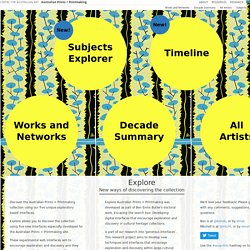
Explore allows you to discover the collection using five new interfaces especially developed for the Australian Prints + Printmaking site. These experimental web interfaces aim to encourage exploration and discovery and they created especially for our collection. They seek to step away from the traditional search and browse model - instead of assuming that you know what you want to find - they allow you to engage in a process of open ended exploration.
Companion to Digital Humanities. DH Resource Guide. From CUNY Academic Commons Welcome to the CUNY Digital Humanities Resource Guide, a collaboratively produced introduction to the field of Digital Humanities.

The guide is a project of the CUNY Digital Humanities Initiative (DHI), a new working group aimed at building connections and community among those at CUNY who are – or would like to be – applying digital technologies to research and pedagogy in the humanities. Introduction Using This Guide The Digital Humanities The Resource Guide. Big? Smart? Clean? Messy? Data in the Humanities. (Please note that a revised version of this post has been published in the Journal for Digital Humanities in december 2013. – The original post is a slightly edited version of a talk I gave at the European Summer School “Culture & Technology at the University of Leipzig, Germany, on July 26 2013.)
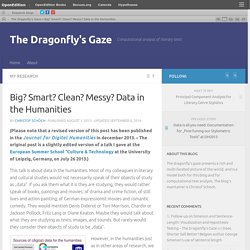
This talk is about data in the humanities. Most of my colleagues in literary and cultural studies would not necessarily speak of their objects of study as „data”. If you ask them what it is they are studying, they would rather speak of books, paintings and movies; of drama and crime fiction, of still lives and action painting; of German expressionist movies and romantic comedy. They would mention Denis Diderot or Toni Morrison, Chardin or Jackson Pollock, Fritz Lang or Diane Keaton. Maybe they would talk about what they are studying as texts, images, and sounds.
DH as Jazz Ensemble. From the William P.

Gottlieb Collection, see: We frequently speak of Digital Humanities projects – in which people from one or several disciplines such as literary studies, musicology and/or art history work together with colleagues from computer science and/or statistics – using concepts like inter- or transdisciplinarity or like collaboration.[] The danger, we quickly notice, lies in the “divison of labor” such arrangements imply. Such division of labor tends to imply a hierarchy of nobler and less noble contributions to the task at hand; depending on how exchangeable contributors become through division of labor, this may involve asymmetric dependency relations; finally, this is a framing in terms of economic efficiency which, to make matters worse, is also reminiscent of Karl Marx’ concept of alienation.
If we don’t fully control and understand the entire research process ourselves, the research results won’t be fully our own. So, let’s play! Notes. Digital Humanities Quarterly, LLC, Managing 100 Digital Humanities Projects: Digital Scholarship & Archiving in King’s Digital Lab James Smithies, King's College London; Carina Westling, King's College London; Anna-Maria Sichani, King's College London; Pam Mellen, King's College London; Arianna Ciula, King's College London Modelling Medieval Hands: Practical OCR for Caroline Minuscule Brandon W.
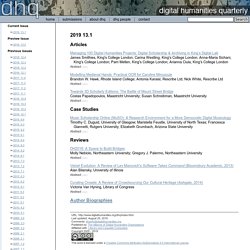
Hawk, Rhode Island College; Antonia Karaisl, Rescribe Ltd; Nick White, Rescribe Ltd. Digital Humanities Questions & Answers. Digital Studies / Le champ numérique. DH@Stanford. Mixed networks, mixed messages. Who's working on digital humanities at Stanford?

As technologists, our impulse is to record and analyze this network, yet as humanists, we can see the problems with this project before we even start. Network analysis has not often been applied to humanistic topics because our data sets and data collection are willfully untidy: no two people, no two relationships, no two objects are alike, so how can we reduce them to a simplistic set of nodes and edges? Yet we're intrigued by the possibility of one more way to look at human relationships, so we created these mixed network graphs — graphs of unlike objects — and analyzed them by asking questions rather than computing answers. Below are three visualizations that reveal different aspects of the mixed network. We created these multiple perspectives in order to shed light on the decisions that go into the creation of a network visualization.
I. First, let's pick out the people involved. II. III. Towards a Rationale of Audio-Text. Bauman 1975 Bauman, R.

"Verbal Art as Performance. " In American Anthropologist, New Series, 77, no. 2 (June 1975): 290-311. Bernstein 2011 Bernstein, C. What Digital Humanists Do. “The digital humanities is what digital humanists do.” — Rafael Alvarado, Day of DH (reprinted in “Day of DH: Defining the Digital Humanities” in Debates in the Digital Humanities) Alvarado's point — that the field of digital humanities is varied and dynamic — is an excellent one.
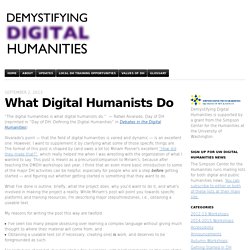
However, I want to supplement it by clarifying what some of those specific things are. The format of this post is shaped by (and owes a lot to) Miriam Posner's excellent “How did they make that?” , which really helped me when I was wrestling with the organization of what I wanted to say. This post is meant as a precursor/companion to Miriam's, because after teaching the DMDH workshops last year, I think that an even more basic introduction to some of the major DH activities can be helpful, especially for people who are a step before getting started — and figuring out whether getting started is something that they want to do. My reasons for writing the post this way are twofold: A knowledge site. Digital humanities. Can Social Media Work for Me? EADH - The European Association for Digital Humanities.
Scholarly Communication and the Digital Humanities: An Interview with Kathleen Fitzpatrick – In the Library with the Lead Pipe. Photo of a class in radio technology at Radcliffe College 1922.
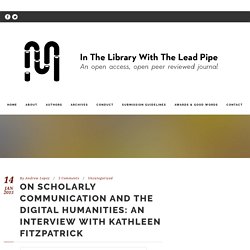
Retrieved from Wikimedia Commons. In Brief: At Temple University Libraries (TUL), librarian Fred Rowland began conducting interviews and sharing them as streaming audio through TUL’s website in 2007. The following interview transcript with digital humanities scholar Kathleen Fitzpatrick offers insight into her work and a discussion about the future of scholarly communication. An introduction has been added to the interview, which addresses both the transcription process and the implications of using digital media to make more scholarship available to a wider audience beyond academia.
By Andrew Lopez, Fred Rowland, and Kathleen Fitzpatrick. Interviews with Authors (2013-14)- Fred Rowland - LibResearch Guides sity. Journal of Digital Humanities. JDH» Getting Started in Digital Humanities. Lisa Spiro When I presented at the Great Lakes College Association’s New Directions workshop on digital humanities (DH) in October, I tried to answer the question “Why digital humanities?”
But I discovered that an equally important question is “How do you do digital humanities?” Although participants seemed to be excited about the potential of digital humanities, some weren’t sure how to get started and where to go for support and training. Building on the slides I presented at the workshop, I’d like to offer some ideas for how a newcomer might get acquainted with the community and dive into digital humanities work.
Center for Digital Humanities and Social Sciences. Mitchell Whitelaw. Natl Intv 4A Networked Cultural Heritage. Piktochart. Spatial Humanities Group. Tagxedo - Word Cloud with Styles. Untitled. Tapor. Tooling Up for Digital Humanities. ToolsForTheDigitalHumanities. UCL Transcribe Bentham. Welcome to Transcribe Bentham By Tim Causer, on 27 March 2013 Jeremy Bentham ‘Many hands make light work. Many hands together make merry work‘, wrote the philosopher and reformer, Jeremy Bentham (1748 – 1832) in 1793. In this spirit, we cordially welcome you to Transcribe Bentham, a double award-winning collaborative transcription initiative, which is digitising and making available digital images of Bentham’s unpublished manuscripts through a platform known as the ‘Transcription Desk‘.
This is an exciting opportunity to make a genuine difference to research and scholarship by contributing to the production of the new edition of The Collected Works of Jeremy Bentham, and to help create for posterity a vast digital repository of Bentham’s writings. Please consult the Transcribe Bentham FAQ for more details on taking part. You can also read more about Jeremy Bentham, his thought and his importance, and consult resources on deciphering historical handwriting. Hello everyone! Hi there. Viewshare. William J Turkel. If you are just getting started with online research, there are some things that are handy to know, and a few tools you might like to set up for yourself. Analog and digital.
When I talk to my students about the difference between analog and digital representations, I use the example of two clocks. The first is the kind that has hour and minute hands, and perhaps one for seconds, too. At some point you learned how to tell time on an analog clock, and it may have seemed difficult. Since the clock takes on every value in between two times, telling time involves a process of measurement. The costs are different. You won’t be able to read everything.